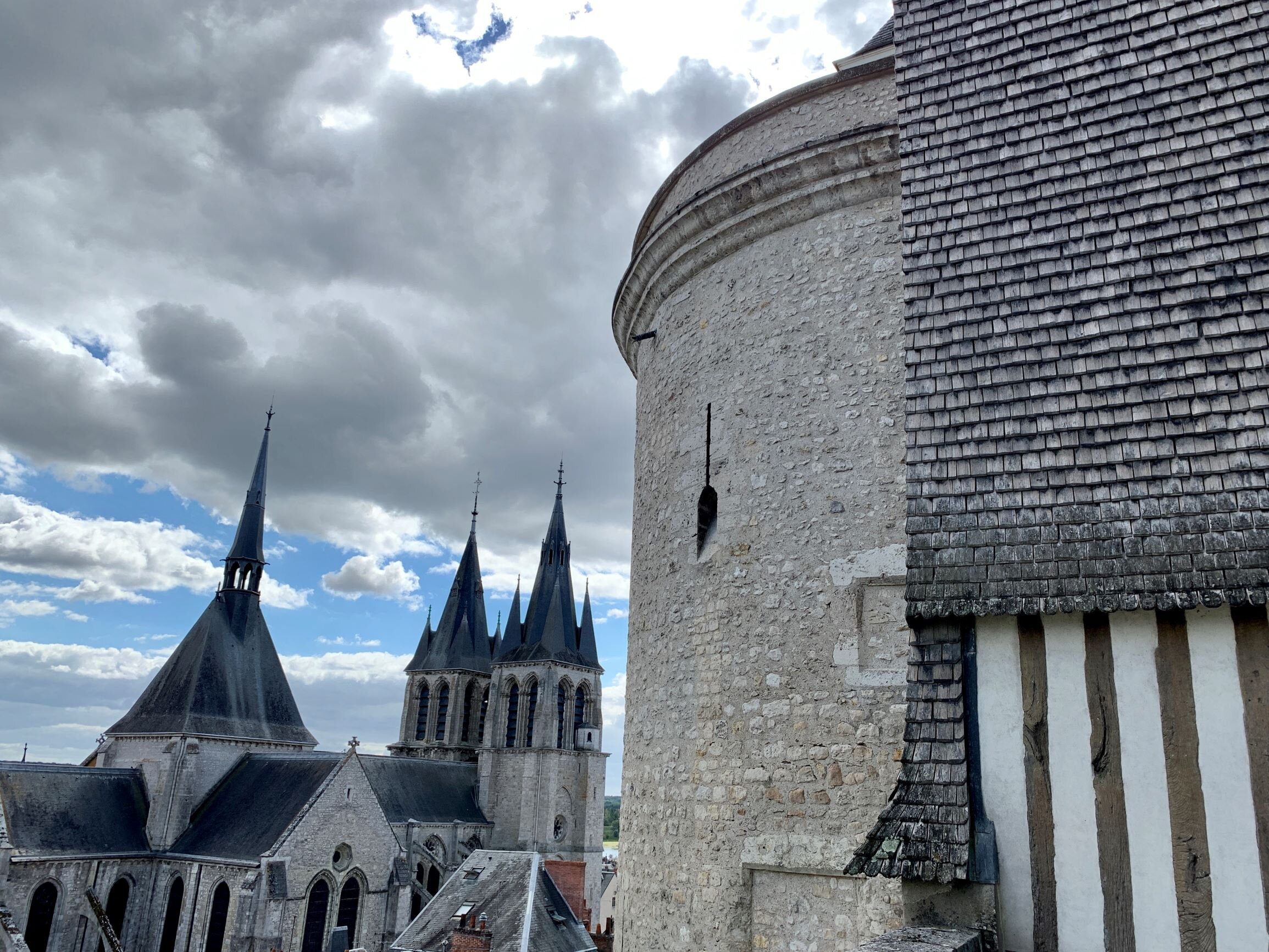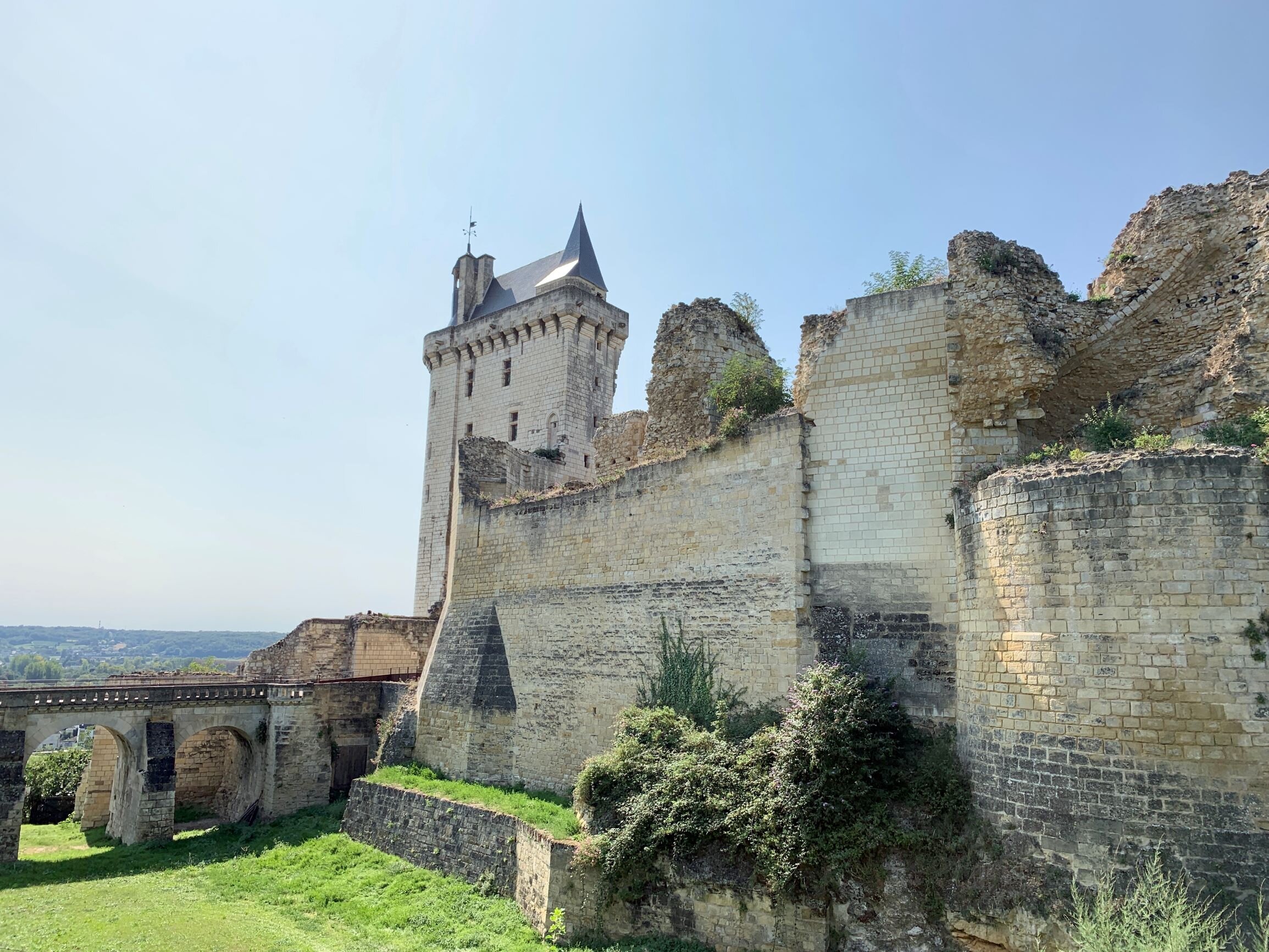French Châteaux: The Best Loire Valley Castles for History
The exterior ramparts of the the Royal Fortress of Chinon in the Loire Valley, France. September 12, 2020.
As I mentioned in my post outlining the most beautiful castles in the Loire Valley, I discovered a fairly clean divide of French châteaux into two categories: Castles to see for history and castles to see for beauty.
Of course, if you visit the Loire Valley of France, you should see a mix of castles: Some resplendent with beauty and some telling stories from history—even if you have a natural inclination toward one or the other.
If you need help prioritizing these castles for the time you have available, read my recommendations guide, which includes my top-three, must-see Loire Valley châteaux. And if you need guidance on how to coordinate a trip to the Loire Valley in the first place, read my article with how-to tips on planning a castle-sightseeing trip.
Most of the Loire Valley castles that I categorize as historic more than beautiful—although they do have their beauty—mostly transitioned into ruins toward the end of the middle ages or early Renaissance. Some crumbled into near nothingness before the French government or an organization (or individual) swept in to preserve them for visitors. In the history castles, as I’ve designated them, you won’t find luxurious living spaces as much as you’ll find dungeons and drawbridges.
Surprisingly, I enjoyed visiting the history castles more than I enjoyed the beauty castles. The beauty makes for better photography, but the history castles stick in memory for the stories they tell and their vivid physical reminders of and lessons about times past.
In alphabetical order, you can review below the best Loire Valley châteaux to see if you’d like to experience and learn about French history:
Château Royal de Blois
We could have—and likely should have—spent more time at the Château Royal de Blois. Though not particularly pretty, this castle has a long and complicated history and can tell a lot of tales about the French kings, their machinations, and the European religious wars.
King Henri III, a protestant king, assassinated his Catholic cousin, the Duke de Guise, in the Blois castle; the king had the duke’s brother, a cardinal, killed here the following day. Revenge came a mere eight months later when a monk killed the king in turn.
The few points of architectural splendor remaining in the Château Royal de Blois include a beautiful exterior staircase in the courtyard and an intricate study in carved wood with secret chambers for hiding documents and jewelry.
Château de Chenonceau
Only one castle appears on my lists for the best French castles for beauty and the best French castles for history: The Château de Chenonceau.
Without question, Chenonceau has nearly unmatched beauty when it comes to castle architecture, interior design and decoration, and landscape architecture. If you went to the Loire Valley to soak up all the beauty, you must see Chenonceau.
Check out these photos and the video for proof:
However, the castle does a magnificent job showcasing its stunning looks while giving context to its history over the years from its conception and creation in the 16th century and its development and use throughout the years, including into the present-day era. (The Château de Chenonceau played a role in both world wars, serving as a military hospital for one and a waystation for refugees fleeing occupied to free France in the other.)
Further, the castle owes its conception and longevity to the involvement of three inimitable women over the years, earning it the name “La Château des Dames” in French (the women’s castle, in English). Katherine Bohier gets credit for the castle’s creation and its development continued via the involvement (and residence) of Diane de Poitiers and Catherine de Medici.
Forteresse Royale de Chinon
I’ll forgive you for thinking that you can pass on The Royal Fortress of Chinon, because the castle has devolved into a ruin over the years.
However, my forgiveness does not exempt you from adding it to your must-see list.
Though a ruin, 11th century Chinon has a fantastic guided tour via tablet, which will recreate for you its ambiance and its history and keep you (and your kids) very well entertained. We spent more time exploring Chinon than we did the nearby and more decorated Azay-le-Rideau, which we visited on the same day (and which you can learn more about in my beauty castles post.)
French King Henry II Plantagenêt considered Chinon his favorite fortress, and Charles VII met here with Joan of Arc before approving her quest to fight for his armies during the Hundred Years War. Also, the 13th century Tower of Courdray imprisoned Knights Templar in the early 1300s; you can see what they believe to be graffiti from the knights preserved on the tower’s interior walls.
Château du Clos-Lucé
In all honesty, I debated whether to mention the Château du Clos-Luce in any of my Loire Valley articles. However, if you find Leonardo da Vinci’s mechanical innovations particularly inspiring, you might like it more than I did. Also, if you have kids in tow, they might enjoy seeing da Vinci’s machines in action (a definite break in the castle-sightseeing routine).
Leonardo da Vinci lived in this castle for a little less than three years at the end of his life at the invitation of the French king François I, who wanted the esteem of having one of the greatest Renaissance artists installed in his court.
However, nothing remains of da Vinci here. (You can find his gravesite in the Château Royal d’Amboise, which I cover in my article highlighting the castles to see for beauty.) Instead, you’ll find more of an “experience” than a château, and not a terribly interesting experience (in my opinion). The Château du Clos-Luce’s keepers have recreated possibilities in the castle and on its grounds, from how da Vinci’s workshop and bedroom could have appeared to recreations of some of his inventions.
The owners have done a great job marketing (and overhyping) the da Vinci link heavily, making this one of the most crowded castles we visited in the Loire Valley.
Château de Langeais
For the most medieval of medieval castles—as medieval as you can find and as complete as you can find—stop at the Château de Langeais.
Here you’ll find a working drawbridge, a stone keep, a parapet walk giving you a knight’s-eye view replete with gaps that allowed the pouring of boiling oil on attackers below, and more. The exterior façade of the castle has the fully fortified appearance, all stone ramparts and drawbridge and crenellations, and the interior façade looks like a luxurious home, with windows and gardens and stonework.
Within the castle, you’ll find the most carefully restored and redecorated medieval living spaces I’ve seen. The benefactor who bought and preserved the Château de Langeais did his best to bring its furnishings and decorations back to the time of the marriage of Charles VIII and Anne of Brittany, which took place in secret here in December 1491 and united the kingdom of France and the area of Brittany (a region hotly contested between France and England).
The furnishings include a series of astoundingly preserved and gorgeous tapestries from the 1500s, including one with astrological symbols and a series of nine with different historical figures, including the biblical David and Joshua, King Arthur, and Alexander the Great, all portrayed as models of courtly honor.
Château de Valançay
Charles Maurice de Talleyrand-Périgord, more familiarly known as Talleyrand, made a smart investment when he bought the Château de Valançay, using it strategically for illustrious political invitations and exclusive parties.
After all, Talleyrand didn’t survive through the French Revolution, the Emperor Napoleon, and the return of the monarchy by chance. The man worked hard for his reputation as one of history’s savviest and cleverest statesmen and diplomats.
Unfortunately, the castle has not managed to maintain its splendor in the years between his death in 1838 and the present day. Sadly, the estate—including the buildings and the grounds—badly show their age and wear. The town around it doesn’t have much to attract, either, though a small chapel a short walk from the castle holds Talleyrand’s grave.
However, despite the lack of visual splendor or local delights at the Château de Valançay, we enjoyed learning more about Talleyrand’s history. Anyone interested in political history, especially during turbulent times, will find a visit to Valançay worthwhile.
The Tales these Castles Could Tell…
Each of these castles could fill a book of history—and they probably already have. Though we might easily default to Disney-esque visions in the Rorshach test of the word “castle,” the stories the medieval castles can tell you, if you let them, will weave much more interesting and colorful pictures in the mind’s eye.
Of course, you should still see the beauty castles, which I’ve covered in my article about the best Loire Valley castles to see for beauty. A mix of history and beauty will keep the castle sightseeing fresh.
For my recommendations on how you can prioritize your castle sightseeing based on the time you have available and your specific interests, read my how-to guide on Loire Valley castle prioritization, which includes my list of top-three must-see châteaux, too.
For ideas on other activities in the area (for a break in the castle sightseeing—although we found that we didn’t need one, to our own surprise), I have yet another article to give you a few ideas.
And if you don’t even know where to start with your Loire Valley châteaux sightseeing-trip planning, I’ve got you covered: Check out my comprehensive how-to guide on planning a trip to see the Loire Valley castles.
Can’t get enough about the Loire Valley? Click here for my full set of Loire Valley articles.


























